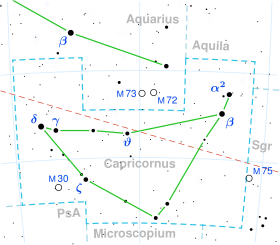Chi Capricorni
| Observation data Epoch J2000.0 Equinox J2000.0 (ICRS) | |
|---|---|
| Constellation | Capricornus |
| Right ascension | 21h 08m 33.62529s[1] |
| Declination | −21° 11′ 37.2177″[1] |
| Apparent magnitude (V) | +5.28[2] |
| Characteristics | |
| Spectral type | A0 V[3] |
| B−V color index | +0.01[2] |
| Astrometry | |
| Proper motion (μ) | RA: +19.83[1] mas/yr Dec.: −60.15[1] mas/yr |
| Parallax (π) | 18.14 ± 0.31 mas[1] |
| Distance | 180 ± 3 ly (55.1 ± 0.9 pc) |
| Absolute magnitude (MV) | +1.59[4] |
| Details[5] | |
| Mass | 2.78 M☉ |
| Luminosity | 21[6] L☉ |
| Surface gravity (log g) | 4.33±0.14 cgs |
| Temperature | 10,878±370 K |
| Metallicity [Fe/H] | −0.41±0.06[7] dex |
| Rotational velocity (v sin i) | 212[3] km/s |
| Age | 251 Myr |
| Other designations | |
| Database references | |
| SIMBAD | data |
Chi Capricorni, Latinized from χ Capricorni, is a star in the southern constellation of Capricornus. Based upon an annual parallax shift of 18.14 mas as seen from the Earth,[1] the star is located about 180 light years from the Sun. It is visible to the naked eye with an apparent visual magnitude of +5.28.[2]
Properties[edit]
This is an A-type main sequence star with a stellar classification of A0 V.[3] It is a candidate Lambda Boötis star, showing a chemically peculiar spectrum with a low abundance of most elements heavier than oxygen.[7] The star is around 251[5] million years old and is spinning rapidly with a projected rotational velocity of 212[3] km/s. It has 2.78[5] times the mass of the Sun and is radiating 21[6] times the solar luminosity from its photosphere at an effective temperature of 10,878 K.[5]
At an angular separation of 1,199[9] arcseconds lies a faint proper motion companion designated HIP 99550. At the estimated distance of Chi Capricorni, this is equal to a projected separation of 28,300 AU.[9] It has a visual magnitude of 10.94[10] and a classification of M0 Vk,[11] indicating this is a red dwarf star.[9]
Chinese Name[edit]
In Chinese, 十二國 (Shíer Guó), meaning Twelve States, refers to an asterism which is represent twelve ancient states in the Spring and Autumn period and the Warring States period, consisting of χ Capricorni, φ Capricorni, ι Capricorni, 38 Capricorni, 35 Capricorni, 36 Capricorni, θ Capricorni, 30 Capricorni, 33 Capricorni, ζ Capricorni, 19 Capricorni, 26 Capricorni, 27 Capricorni, 20 Capricorni, η Capricorni and 21 Capricorni.[12] Consequently, the Chinese name for χ Capricorni itself represents the state Qi (齊),[13] together with 112 Herculis in Left Wall of Heavenly Market Enclosure (asterism).[14]
R.H.Allen had opinion that χ Capricorni, together with φ Capricorni, were represent the state Wei (魏).[15]
References[edit]
- ^ a b c d e f van Leeuwen, F. (2007), "Validation of the new Hipparcos reduction", Astronomy and Astrophysics, 474 (2): 653–664, arXiv:0708.1752, Bibcode:2007A&A...474..653V, doi:10.1051/0004-6361:20078357, S2CID 18759600.
- ^ a b c Evans, D. S. (1966), "Fundamental data for Southern stars (6th list).", Royal Observatory Bulletin, 110: 185, Bibcode:1966RGOB..110..185E.
- ^ a b c d Royer, F.; Zorec, J.; Gómez, A. E. (February 2007), "Rotational velocities of A-type stars. III. Velocity distributions", Astronomy and Astrophysics, 463 (2): 671–682, arXiv:astro-ph/0610785, Bibcode:2007A&A...463..671R, doi:10.1051/0004-6361:20065224, S2CID 18475298.
- ^ Anderson, E.; Francis, Ch. (2012), "XHIP: An extended hipparcos compilation", Astronomy Letters, 38 (5): 331, arXiv:1108.4971, Bibcode:2012AstL...38..331A, doi:10.1134/S1063773712050015, S2CID 119257644.
- ^ a b c d David, Trevor J.; Hillenbrand, Lynne A. (2015), "The Ages of Early-Type Stars: Strömgren Photometric Methods Calibrated, Validated, Tested, and Applied to Hosts and Prospective Hosts of Directly Imaged Exoplanets", The Astrophysical Journal, 804 (2): 146, arXiv:1501.03154, Bibcode:2015ApJ...804..146D, doi:10.1088/0004-637X/804/2/146, S2CID 33401607.
- ^ a b McDonald, I.; et al. (2012), "Fundamental Parameters and Infrared Excesses of Hipparcos Stars", Monthly Notices of the Royal Astronomical Society, 427 (1): 343–57, arXiv:1208.2037, Bibcode:2012MNRAS.427..343M, doi:10.1111/j.1365-2966.2012.21873.x, S2CID 118665352.
- ^ a b Andrievsky, S. M.; et al. (December 2002), "The elemental abundance pattern of twenty lambda Bootis candidate stars", Astronomy and Astrophysics, 396 (2): 641–648, Bibcode:2002A&A...396..641A, doi:10.1051/0004-6361:20021423.
- ^ "chi Cap". SIMBAD. Centre de données astronomiques de Strasbourg. Retrieved 2017-05-09.
{{cite web}}: CS1 maint: postscript (link) - ^ a b c Dhital, Saurav; et al. (June 2010), "Sloan Low-mass Wide Pairs of Kinematically Equivalent Stars (SLoWPoKES): A Catalog of Very Wide, Low-mass Pairs", The Astronomical Journal, 139 (6): 2566–2586, arXiv:1004.2755, Bibcode:2010AJ....139.2566D, doi:10.1088/0004-6256/139/6/2566, S2CID 661494.
- ^ Høg, E.; et al. (March 2000), "The Tycho-2 catalogue of the 2.5 million brightest stars", Astronomy and Astrophysics, 355: L27–L30, Bibcode:2000A&A...355L..27H, doi:10.1888/0333750888/2862.
- ^ Gray, R. O.; et al. (July 2006), "Contributions to the Nearby Stars (NStars) Project: spectroscopy of stars earlier than M0 within 40 pc-The Southern Sample", The Astronomical Journal, 132 (1): 161–170, arXiv:astro-ph/0603770, Bibcode:2006AJ....132..161G, doi:10.1086/504637, S2CID 119476992.
- ^ (in Chinese) 中國星座神話, written by 陳久金. Published by 台灣書房出版有限公司, 2005, ISBN 978-986-7332-25-7.
- ^ (in Chinese)zh:北方中西星名對照表
- ^ (in Chinese)zh:北天中西星名對照表
- ^ Allen, Richard Hinckley (1963), "Capricornus", Star Names, Their Lore and Meaning, Dover, retrieved 2017-05-09.

